Design, Construction, and Operation of the Small Wastewater Systems - 10...
Chapter 10 - Sludge Disposal...
10-1. General...
( a ) Overview.
The disposal of sludges and septage generated at treatment facilities is an important consideration in the selection and
design of such facilities. This chapter provides an overview of current sludge disposal requirements and restrictions.
( b ) Current standards.
The current EPA Standards for the Use or Disposal of Sewage Sludge became effective March 22, 1993 (40 CFR Part 503). The
new standards attempt to unravel problems that heretofore have caused a number of inconsistencies in the use and disposal
of wastewater-generated sludges. These standards address three principal sludge issues: land-applied, distributed, or
marketed sludge; disposal at dedicated sites or in sludge-only landfills (monofills); and incineration in sludge-only
incinerators. The new standards also affect septage disposal. Generally, burial in landfills, either monofills or with
municipal wastes, has been found to be the most cost-effective method of disposal.
10-2. Definitions...
"Sludge" is defined as the residual material removed from wastewater treatment facilities. A new term, "biosolids",
suggests the beneficial usage of sludge. The definition of "biosolids" is now accepted as those primarily organic solid
products produced by wastewater treatment processes that can be beneficially recycled. Other definitions of interest
follow. (Note: the definitions apply specifically to the 1993 rule and may differ from definitions previously provided.)
- A Class I sludge management facility is any publicly owned treatment works, including federally owned treatment works.
- Domestic septage is either liquid or solid material removed from a septic tank, cesspool, portable toilet, marine
sanitation device, or similar treatment works that receives only domestic wastewater. Domestic septage does not include
liquid or solid material removed from a septic tank, cesspool, or similar treatment works that receives either commercial
wastewater or industrial wastewater and does not include grease removal from grease traps.
- Domestic wastewater is waste and wastewater from humans or operations that is discharged to, or otherwise enters, a
treatment works.
- A person is an individual, association, partnership, corporation, municipality, state or Federal agency, or an agent or
employee thereof.
- Treatment of sludge is its preparation for final use or disposal including, but not limited to, thickening,
stabilization, and dewatering of sludge. Sludge treatment does not relate to storage of wastewater sludge.
- Wetlands means those areas inundated or saturated by surface water or groundwater at a frequency and duration to support,
and that under normal circumstances do support, a prevalence of vegetation typically adapted for life in saturated solid
conditions. Wetlands include swamps, marshes, bogs, and similar areas.
10-3. Management Standards...
( a ) Rule 40 CFR 503.
The 40 CFR 503 rule includes standards that apply to generators, processors, beneficial users, or disposers of sludge or
septage wastes. Briefly, the rule establishes two new national standards. First, based on risk assessment, it sets
standards for 10 heavy metals, pathogens (mainly disease-causing viruses, bacteria, and parasites), and emissions from
incinerators (not under consideration at remote recreational or isolated areas). Second, there is a standard for managing
septage and sewage sludge and for their disposal. Prescribed management practices were designed to limit human and
ecological exposure to contaminants and then to ensure that the sludge produced is used on the land or is properly disposed
of in a manner that protects both human health and the local environment.
( b ) General practices.
General management practices include pollutant monitoring, pathogen reduction, vector attraction reduction, site
restrictions, protection of threatened or endangered species, and record keeping.
( c ) Specific practices—land application.
Specific management practices for land application include the use of an agronomic rate of application based on the needs
of site-specific crops; application in ways that prevent runoff to waters of the U.S. including a buffer zone of 10 m;
labeling or instructions for those who purchase sludge-derived products for individual use; and site restrictions.
( d ) Specific practices—surface disposal.
Specific management practices for surface disposal methods include more stringent site restrictions, including those on
grazing animals, crops, and human contact; certification or monitoring to ensure no contamination of groundwater; air
monitoring for methane gas; and runoff collection requirements.
10-4. Toxic Metal Regulations...
The 40 CFR 503 rule contains limits for 10 metal pollutants for land application: arsenic, cadmium, chromium, copper, lead,
mercury, molybdenum, nickel, selenium, and zinc. The rule also specifies limits for 3 toxic metals for surface disposal :
arsenic, chromium, and nickel. See paragraph 10-10 for surface disposal pollutant limits.
10-5. Effect of Land Application...
The new rule contains two regulatory strategies for land application depending on the quality of the sludge in question.
Sludges that are shown or proven to be of "exceptionally high quality" become exempt from further regulatory controls and
can be used as freely as other soil amendments or fertilizer would be. Sludges of good quality that do not meet the
"exceptionally high quality" standards can also be used on land if certain management practices are observed.
10-6. Pathogen and Vector Attraction Reduction...
Pathogen and vector attraction reduction requirements are major changes from previous federal sludge regulations and include
two classes of pathogen reduction: Class A and Class B. Class A is a Process to Further Reduce Pathogens (PFRP) standard;
Class B is a Process to Significantly Reduce Pathogens (PSRP) standard (see paragraph 10-11).
10-7. Exclusions...
The new rule does not apply to sludges co-landfilled with solid waste, sludges co-incinerated with solid waste, grit and
screenings, and drinking water treatment sludges. Sewage scum is not excluded and is discussed in paragraph 10-14; any scum
collected in wastewater clarifier operations falls within the definition of sludge.
10-8. Land Application Pollutant Limits...
Maximum allowable metals concentrations established in the 1993 rule for land application of sludge are shown in Table 10-1.
Specifically :
- Sludge cannot be applied if the pollutant concentration exceeds the maximum allowable concentrations.
- If sludge is applied to land, either the cumulative loading rate or pollutant concentrations must not be exceeded.
- If sludge is applied to a lawn or home garden, the pollutant concentrations must not be exceeded.
- If sludge is sold or given away in a bag or container, the pollutant concentration or the application rate must not be
exceeded.
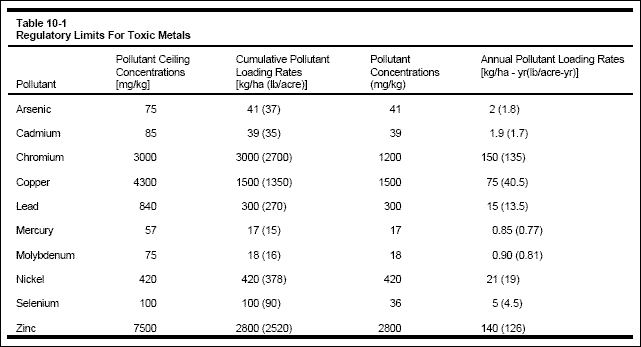 10-9. Land Application Management Practices...
Sludge shall not be land applied if :
10-9. Land Application Management Practices...
Sludge shall not be land applied if :
- It is likely to adversely affect threatened or endangered species.
- The land is flooded, frozen, or snow-covered so that with resulting runoff the sludge enters a wetland or other waters.
- It is 10 m (33 ft) or less from surface waters.
- It exceeds the agronomic rate, unless it is applied to a permitted reclamation site.
For sludges sold or given away in bags or other containers, an information sheet or label shall be provided to the user.
The label or information sheet shall contain the following information :
- Name and address of the generator.
- The annual application rate at which the sludge may be applied.
- A statement that the application rate shall not be exceeded.
10-10. Surface Disposal Pollutant Limits...
The general requirements for surface disposal are :
- Disposal is prohibited in wetlands or unstable areas.
- Disposal is prohibited when the site is within 60 m (200 ft) of a geologic fault unless a special permit is obtained.
- Closure and post-closure plans are required six (6) months prior to site closure.
- There are no pollutant limits for surface disposal sites with liners and leachate collection systems.
- There are pollutant limits for arsenic, chromium, and nickel for surface disposal sites without liners and leachate
collection. The limit depends on the distance from property boundaries as indicated in Table 10-2.
For surface disposal, there are certain required management practices as well as frequency of monitoring requirements.
10-11. Pathogens and Vector Attraction Reduction...
There are differing requirements for Class A and Class B pathogens and vector attraction reductions as follows :
( a ) Class A pathogen reduction.
All options require pathogen reduction to indicate that the sludge has either: <1 000 MPN fecal coliforms per gram total
solids, or <3 MPN Salmonella per four grams of total solids; and one of the following six alternatives: control time and
temperature, raise the sludge pH, reduce enteric viruses and helminth ova (low pathogen sludge), reduce enteric viruses
and helminth ova (normal sludge), process to further reduce pathogens treatment (see paragraph 10-12), and process to
further reduce pathogens equivalent treatment (see paragraph 10-12).
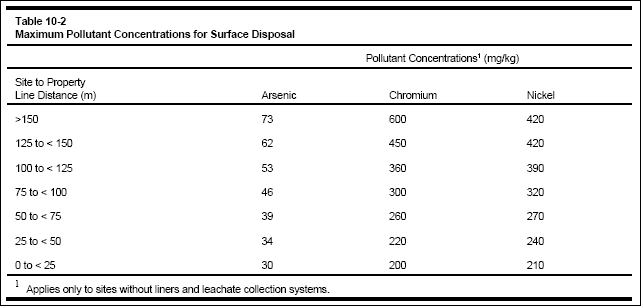
( b ) Class B pathogen reduction.
( 1 ) There are three options for Class B pathogen reduction: <2,000,000 MPN coliforms per gram total solids (geometric
mean of seven samples); PSRP (Process to Significantly Reduce Pathogens treatment (see paragraph 10-12); and PSRP
equivalent treatment (see paragraph 10-12).
( 2 ) Five site restrictions also apply :
- Food crops—no harvesting after sludge application for 14 to 38 months depending upon type of crop grown and how sludge is
applied.
- Feed crops—no harvesting for 30 days after sludge application.
- Pasture—no animal grazing for 30 days after sludge application.
- Turf—no harvesting for one year after sludge application.
- Public access—restricted access for 30 days (after 30 days for low exposure areas; one year for high exposure areas).
( 3 ) There are twelve methods of vector attraction reduction for land application, surface disposal, and septage (see
Table 10-3).
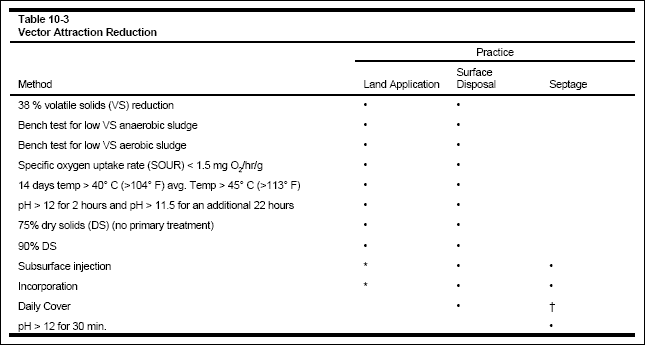 10-12. Pathogen Treatment Processes...
Composting of sewage sludges is covered in the pathogen treatment processes.
10-12. Pathogen Treatment Processes...
Composting of sewage sludges is covered in the pathogen treatment processes.
( a ) Process to significantly reduce pathogens. When composting is practiced using either the invessel composting
method or the windrow composting method, the temperature of the sewage sludge is to be raised to 40 O C
(104 O F) or higher and remain at 40 O C (104 O F) or higher for five days. For four
hours during the five days, the temperature in the pile must exceed 55 O C (131 O F).
( b ) Process to further reduce pathogens. When composting using either the within-vessel composting method or the static
aerated pile composting method, the temperature of the sewage sludge is maintained at 55 O C
(131 O F) or higher for three days. Using the windrow composting method, the temperature of the sewage sludge
is to be maintained at 55 O C (131 O F) for 15 days or longer. During the period when the compost is
maintained at 55 O C (131 O F) or higher, there shall be a minimum of five (5) turnings of the
windrow.
10-13. Septage Applied to Agricultural Land, Forests, or Reclamation Sites...
Part 503 imposes separate requirements for domestic septage applied to agricultural land, forests, or a reclamation site.
If domestic septage is applied to public contact sites or home lawns or gardens, the same requirements must be met as for
bulk biosolids which are land applied (general requirements, pollutant limits, pathogen and vector attraction reduction
requirements, management practices, frequency monitoring requirements, as well as record keeping and reporting
requirements).
10-14. Wastewater Scum...
( a ) Components.
Scum is a minor component of wastewater solids collection and consists of all materials that float to the liquid surface of
unit processes. In the primary sedimentation or clarification units, scum generally includes little biological foam or
skimmings. The secondary sedimentation or clarification process produces almost entirely biological scum and foam and is
generally minimal in volume.
( b ) Disposal.
( 1 ) Scum disposal is regulated by the 1991 EPA 40 CFR 258 (Criteria for Municipal Solid Waste Landfills) as well as the
1993 EPA 40 CFR 503 (Standards for the Use and Disposal of Sewage Sludge). Part 503 defines sewage sludge as, but not
limited to, "...domestic septage; scum and solids removed in primary, secondary or advanced wastewater treatment processes;
and a material derived from sewage sludge." The description is apt, as scum has many of the characteristics of wastewater
solids/residues. Scum may be disposed with sewage sludge.
( 2 ) Under the 1991 EPA 40 CFR 258 rule, sewage sludge and scum may be disposed of in municipal solid waste landfills and
are jointly defined as "...any solid, semi-solid, or liquid waste generated from a municipal, commercial, or industrial
wastewater treatment plan....".
( 3 ) Under the 1993 EPA 40 CFR 503 rule, land application and surface disposal is regulated and specifically refers to
composting practices. Any scum included in surface disposal or land application must meet certain pollutant limits, Class A
or Class B pathogen requirements, or vector reduction requirements and some additional management requirements.
10-15. Composting Methods...
( a ) Static pile process.
Schematics for an aerated static pile, a conventional windrow, and an aerated windrow composting process are shown in
Figure 10-1. The extended-aerated static pile process involves mixing the dewatered sludge with a bulking agent followed by
active composting in specially constructed piles as shown in Figure 10-2.
( b ) Windrow process.
The conventional windrow process shown in Figure 10-1 involves initial mixing of dewatered sludge with a bulking agent such
as finished compost and supplemented with an external amendment followed by the formation of long windrows. The aerated
windrow process is similar to the conventional windrow process with one exception, i.e., a system for induced aeration is
provided in addition to aeration by turning with a mobile composter.
( c ) Compositing considerations.
Important considerations in static pile composting include wood chip usage, initial mixing, pile construction, composting
period, process control, drying, screening, and curing. Considerations for windrow composting include windrow formation,
composting period, drying, and dust generation.
10-16. Composting Additives/Amendments/Bulking Agents...
Addition of carbonaceous materials in the composting process may resolve other unrelated disposal problems. Where tree
cutting, leaf collection, and storm debris cleanup present a disposal problem, some of this material can be used in the
composting process as carbonaceous additives. Alternately, many readily available materials such as sawdust, bark or wood
chips, shredded newsprint, rice or peanut hulls, and corncobs have been successfully utilized as carbonaceous additives.
Leaves, straw, and shredded tires have also been successfully used. If the material is biodegradable, thus helping to
promote biological activity, it is called an amendment. Bulking agents are primarily used to provide structural support
and maintain air space in the windrows and piles.
10-17. Equipment...
Equipment at composting operations varies considerably. Turning piles in windrow composting is accomplished by commercial
rototillers, front-end loaders, or specially designed turning machines such as Cobey Composters.
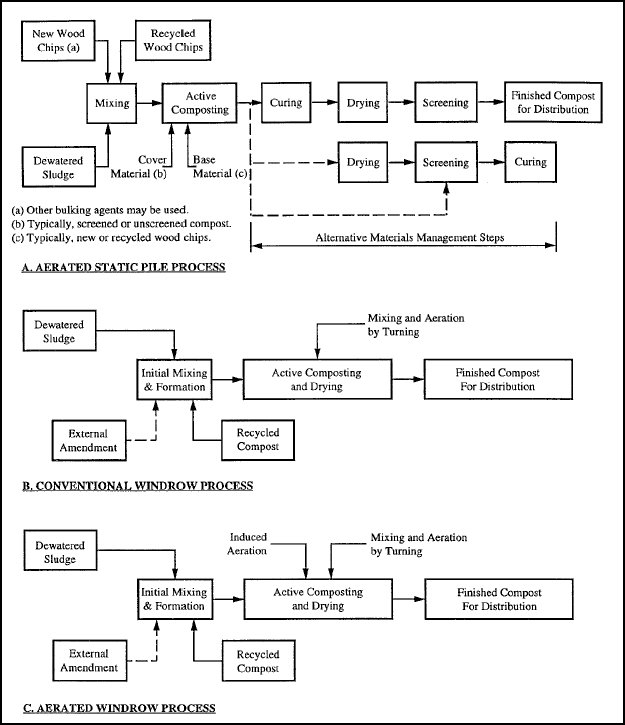
Figure 10-1. Sludge compositing process schematics.
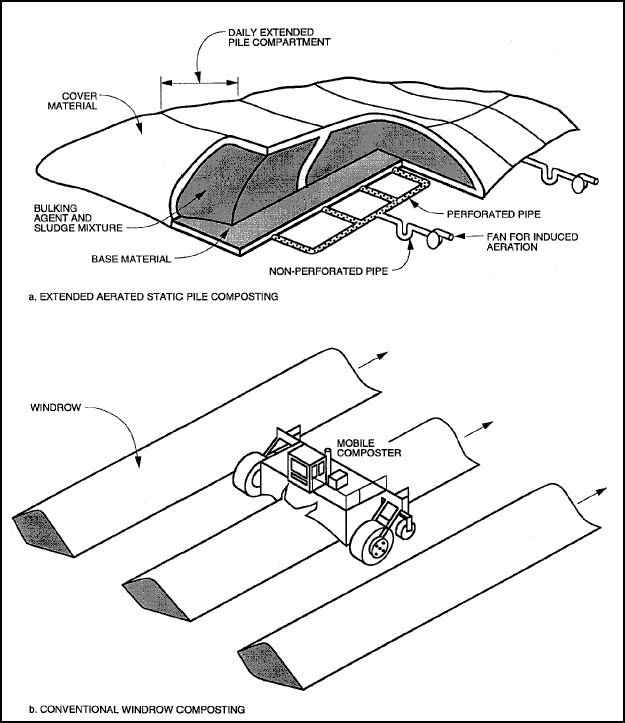
Figure 10-2. Sludge compositing methods
10-18. Guidance...
The best U.S. Army document relating to sludge handling and disposal at military installations is TM 5-814-3. Other
pertinent sources for sludge/biosolids are found in EPA/332/R-93/003, EPA/625/R-92/013, and EPA/831/B-93/002b.






